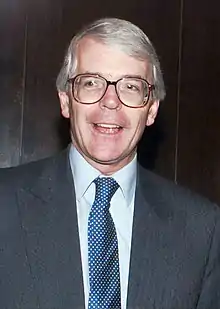Shy Tory factor
The shy Tory factor is a name given by British opinion polling companies to a phenomenon first observed by psephologists in the early 1990s. They observed that the share of the electoral vote won by the Conservative Party (known colloquially as the "Tories") was significantly higher than the equivalent share in opinion polls.[1] The accepted explanation was that so-called "shy Tories" were voting Conservative after telling pollsters they would not. The general elections held in 1992 and 2015 are examples where it has dramatically affected the overall result, but has also been discussed in other elections where the Conservatives did unexpectedly well. It has also been applied to the success of the Republican Party in the United States.[1]

1992 general election
In the 1992 general election, the final UK opinion polls gave the Conservatives between 38% and 39% of the vote, about 1% behind the Labour Party – suggesting that the election would produce a hung parliament or a narrow Labour majority and end 13 years of Tory rule. In the final results, the Conservatives received almost 42% (a lead of 7.6% over Labour) and won their fourth successive general election, though they now had a 21-seat majority compared to the 102-seat majority they had gained in the election five years previously. As a result of this failure to "predict" the result, the Market Research Society held an inquiry into the reasons why the polls had been so much at variance with actual public opinion. The report found that 2% of the 8.5% error could be explained by Conservative supporters refusing to disclose their voting intentions; it cited as evidence the fact that exit polls on election day also underestimated the Conservative lead.
After the 1992 election, most opinion pollsters altered their methodology to try to correct for this observed behaviour of the electorate.[1] The methods varied for different companies. Some, including Populus, YouGov and ICM Research, have adopted the tactic of asking their interviewees how they had voted at the previous election, and then assumed that they would vote that way again at a discounted rate.[2] Others weighted their panel so that their past vote was exactly in line with the actual result of the election. For a time, opinion poll results were published both for unadjusted and adjusted methods. Polling companies have found that telephone and personal interviews are more likely to generate a shy response than automated calling or internet polls.[2]
2015 general election

Opinion polls for the 2015 general election also underestimated the Conservative vote, with most polls predicting a hung parliament, and exit polls suggesting Conservatives as the largest party but not majority, whereas the actual result was a slim Conservative majority of 12 seats.[3] Of the 92 election polls which met the standards of the British Polling Council in the six weeks prior to the 2015 election, none foresaw the 6.5% difference in the popular vote between the Conservative Party and Labour Party. One poll had Labour leading by 6%, two polls had Labour ahead by 4%, 7 polls had Labour ahead by 3%, 15 polls had Labour ahead by 2%, 17 polls had Labour ahead by 1%, 17 polls had a dead heat, 15 polls had the Conservatives ahead by 1%, 7 polls had the Conservatives ahead by 2%, 3 polls had the Conservatives ahead by 3%, 5 polls had the Conservatives ahead by 4%, one poll had the Conservatives ahead by 5% and two polls had the Conservatives ahead by 6%. The two polls that gave the Conservatives a 6% lead were published two weeks before the voting, and the final polls from those polling companies, published on the eve of the voting, gave a dead heat and a 1% Labour lead.[4] The result was eventually a Conservative Party majority with a popular vote share of 37.1% with the Labour Party achieving 30.4%. It was later widely claimed in the media that the "Shy Tory effect" had again occurred as it had done in 1992.[5]
The British Polling Council subsequently launched an independent enquiry into how polls were so wrong amid widespread criticism that polls are no longer a trustworthy avenue of measuring voting intentions.[6][7] This enquiry found that, contrary to the popular reporting, there was no Shy Tory Factor in the election, and the polling had been incorrect for other reasons, most importantly unrepresentative samples.[8]
See also
References
- Mount, Harry (4 November 2004). "Republicans shyly make their presence felt". www.telegraph.co.uk. Retrieved 3 November 2010.
- Sexton, Richard (8 April 2010). "Election 2010: Tackling the Shy Tory problem". www.guardian.co.uk. Retrieved 3 November 2010.
- Cowling, David (8 May 2015). "Election results: How did pollsters get it so wrong?". BBC News.
- Cowling, David (17 May 2015). "Election 2015: How the opinion polls got it wrong". BBC News. Retrieved 2015-05-17.
- Elgot, Jessica (2015-05-08). "How 'shy Tories' confounded the polls and gave David Cameron victory". The Guardian. ISSN 0261-3077. Retrieved 2016-08-09.
- "Why did the election pollsters get it so wrong?". The Guardian. 14 May 2015. Retrieved 2015-05-17.
- Stone, Jon (8 May 2015). "There's going to be an independent inquiry into why the pre-election polls were so inaccurate". The Independent. Retrieved 2015-05-17.
- "Report of the Inquiry into the 2015 British general election opinion polls" (PDF).